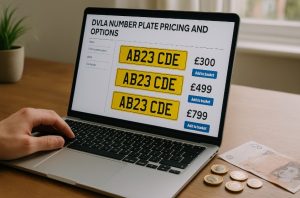
DVLA Number Plate Changes October: What Drivers Need to Know?
The DVLA is set to introduce significant number plate changes this October, offering UK motorists a new wave of personalised registration options.
With fresh prefix combinations and updated pricing structures, these changes provide a unique opportunity for drivers seeking distinct vehicle identifiers.
Available from 10am on 7th October, the new plates follow strict DVLA regulations and legal requirements.
This guide outlines what drivers need to know about the latest updates, costs, legalities, and how to secure a plate.
What Are the DVLA Number Plate Changes Happening in October 2025?

The DVLA’s October 2025 update marks the release of a new series of prefix-style number plates, giving motorists the chance to secure fresh personalised registrations.
While regular biannual updates take place every March and September under the standard vehicle registration system, the October update focuses on prefix combinations that allow for a more customised approach to vehicle identification.
Unlike the current-style plates, which include a location identifier and a date code, the prefix plates start with a single letter, followed by two numbers and three randomly generated letters.
These combinations are ideal for those looking to incorporate initials, names, or other personalised elements into their number plate.
The October release is particularly important for those seeking alternatives to the conventional format and wanting a unique identifier for their vehicle.
Personalised plates have become a symbol of individuality for many car owners, as well as a valuable investment opportunity for collectors.
This prefix release comes after the “75” series plate launched in September 2025.
That rollout was part of the DVLA’s biannual update of standard registrations, which serve the primary purpose of tracking when a vehicle is first registered. In contrast, the October changes cater to buyers looking for exclusivity.
When Will the New DVLA Number Plates Be Available for Purchase?
Motorists interested in securing a new personalised prefix plate will be able to access the DVLA’s official personalised registration platform starting at 10:00 AM on Tuesday, 7th October 2025.
The system is expected to experience high traffic during the initial hours of release due to demand for certain popular combinations.
The DVLA platform will allow users to:
- Search by letter or number combinations
- Filter results by keyword or initials
- Check availability in real time
Customers can complete their purchase directly through the website and receive a certificate of entitlement (V750), which can be used to assign the number to a vehicle at any time. The process is fully digital, and most buyers receive confirmation within minutes.
Motorists are advised to register an account with the DVLA platform in advance and prepare potential combinations of interest before the sale begins to improve their chances of securing their preferred number plate.
What Do the New Prefix Combinations Look Like?
The new prefix registrations being introduced in October will begin with letters ranging from A to H and be paired with the numbers 27, 28 or 29. This gives rise to thousands of potential plate combinations, each with three trailing letters.
The table below shows some common formats included in the release and a few examples:
| Prefix Format | Example Combinations |
| A27 | A27 SEA, A27 REX |
| B28 | B28 SAR, B28 JON |
| C29 | C29 LEE, C29 KAY |
| D27 | D27 TOM, D27 MAX |
| F29 | F29 EVA, F29 ZAK |
| H28 | H28 BEN, H28 LOU |
This format allows for creative interpretations, especially when buyers use letter-number pairings to represent initials, birthdays, or meaningful words.
For example, a plate like D29 DAN might appeal to someone named Daniel born in 2029 or someone seeking a personalised look for branding purposes.
These registrations follow the traditional format used in older vehicle plates in the UK before the year-based system was introduced.
As such, they are popular among classic car owners and enthusiasts looking to match the period styling of their vehicle.
How Much Do the New DVLA Registrations Cost?

Prices for the new prefix registrations vary depending on the popularity and letter combination.
While the base price starts at £250, including VAT and assignment fees, certain letters are considered more desirable and therefore priced higher.
Below is a table showing pricing details for each prefix group:
| Prefix Letter | Example Plate | Price (Including VAT & Assignment) |
| A | A27 SEA | £599 |
| B | B28 SAR | £799 |
| C or H | C28 SEA, H28 SEA | £499 |
| D | D29 SEA | £699 |
| F | F27 SEA | £399 |
The pricing structure reflects the potential value or appeal of specific combinations.
For instance, prefixes like “B” are often associated with personal names and may attract more interest, resulting in a higher price tag.
The DVLA allows buyers to bid on specific plates during timed auctions, especially for highly sought-after combinations.
However, the plates released in this batch are fixed-price and sold on a first-come, first-served basis.
Why Are These DVLA Plate Changes Significant for Motorists?
The DVLA’s October 2025 release is more than a routine update. It introduces a significant opportunity for motorists to own a piece of personal identity on the road.
These prefix-style number plates allow greater customisation and cater to a growing market of drivers seeking individuality and value in their vehicle registrations.
Increased Personalisation for Drivers
The October changes introduce thousands of new combinations that can be tailored to reflect a driver’s name, initials, special dates, or even a business name.
For many vehicle owners, a personalised plate is an extension of their identity, offering a subtle yet noticeable way to stand out.
Unlike standard registration formats that are date-coded and often generic, prefix-style plates allow for more flexibility.
For example, a registration like D29 TOM could appeal to someone named Tom born in 2029, or someone commemorating a special event.
The ability to incorporate personal relevance into a number plate adds emotional value.
Branding and Business Visibility
Beyond personal use, the new plates also present unique branding opportunities for small business owners, tradespeople, or entrepreneurs.
A cleverly selected plate can double as mobile advertising when the vehicle is in use.
A number plate such as C27 TAX might be ideal for a private hire driver or accountant.
Similarly, plates like A28 LAW or F29 ART can reinforce professional identity while on the move.
These options are particularly valuable for sole traders or local businesses that rely on recognisability and word-of-mouth exposure.
Exclusivity and Limited Availability
Unlike regular number plates issued in March and September, which follow a predictable pattern and format, prefix-style plates are released in limited batches.
Once sold, many combinations may not be available again, creating a sense of exclusivity.
This limited nature adds appeal for collectors and those looking to invest in plates that could increase in value over time.
Certain letter and number combinations become more desirable based on trends, celebrity influence, or cultural relevance, making early access crucial for serious buyers.
Investment and Resale Potential
Personalised number plates are increasingly seen as investment assets. Over time, the value of a rare or cleverly-worded registration can rise significantly, especially when the combination becomes desirable in the market.
Registrations featuring short formats, popular names, or catchy acronyms have historically achieved high resale values through DVLA auctions or private sales.
The October release could contain future high-value combinations for those who identify them early.
Enhanced Appeal for Modern and Electric Vehicles
With the continued rise of electric and hybrid vehicles, many drivers are looking for ways to make their cars stand out.
Customised plates offer a visual distinction, especially when combined with the green identifier strip now available for zero-emission vehicles.
Motorists purchasing high-end or technologically advanced cars often seek a number plate that matches the sophistication of their vehicle.
A personalised plate can complement the look and feel of a premium car, contributing to its perceived status on the road.
Flexibility in Assignment and Retention
The DVLA allows prefix-style plates to be purchased, retained, and assigned at a later time. This flexibility means a motorist can secure a desirable plate now and apply it to a future vehicle, or simply hold it as an asset.
Once purchased, plates come with a V750 Certificate of Entitlement, which is valid for 10 years. The certificate can be renewed, assigned to a vehicle, or even sold to another party.
This feature adds practical value for those not ready to apply the plate immediately but wishing to lock in availability.
Support for Enthusiasts and Classic Car Owners
Prefix-style plates are particularly appealing to classic car owners or enthusiasts restoring older vehicles. These plates can match the styling or era of older cars, providing authenticity and enhancing overall appearance.
Unlike modern registrations that may look out of place on vintage models, prefix registrations such as F28 OLT or D29 RST can blend seamlessly with the car’s design and age.
This compatibility has made prefix releases a favourite among collectors aiming for period-correct restorations.
What Are the UK Rules for Legal Number Plates?

Despite the creativity that personalised number plates allow, the DVLA enforces strict regulations to ensure road safety and consistent identification across the UK.
All number plates must follow the same legal standards, regardless of format.
Legal requirements include:
- Front plates must display black characters on a white background
- Rear plates must display black characters on a yellow background
- Characters must use the Charles Wright 2001 typeface
- No changes to spacing or font styles are allowed
Plates issued or replaced after September 2021 must include a British Standard number (BS AU 145e) to confirm compliance with visibility, durability, and reflective standards.
Optional elements such as 3D characters and national identifiers are permitted, but only when supplied by DVLA-approved manufacturers.
Motorists who violate number plate rules may face enforcement action. The most common violations include:
- Incorrect spacing to form words
- Decorative backgrounds or borders that obscure readability
- Use of unapproved fonts or styles
- Plates that don’t include a British Standard marking
Drivers using illegal or non-compliant plates risk a fixed penalty notice of £100, and repeat offences can result in fines of up to £1,000. Furthermore, vehicles with non-compliant plates may fail their MOT test and invalidate insurance policies.
Law enforcement agencies across the UK are now actively targeting non-standard plates using Automatic Number Plate Recognition (ANPR) systems, ensuring compliance and issuing penalties where necessary.
How Can Motorists Check Retention Documents for Personalised Plates?

For drivers who have already purchased a personalised registration, it’s important to understand the documentation associated with plate retention. The DVLA offers two main types of retention certificates:
- V750 Certificate: Issued when a number plate has never been assigned to a vehicle
- V778 Retention Document: Issued when a plate has been removed from a vehicle and is held for future use
Both documents allow the plate holder to retain the rights to the registration for up to 10 years, after which a renewal is required. Failure to renew these documents before their expiry could result in the permanent loss of the registration number.
Motorists are advised to:
- Check the expiry date listed on the certificate
- Renew in advance through the DVLA website
- Ensure details match their current address and contact information
Retention documents can also be transferred digitally via DVLA’s online services, making it easier for individuals to manage their personalised plates even if they sell or change vehicles.
Conclusion
October’s DVLA number plate release presents motorists with an opportunity to secure unique, compliant, and highly personalised registrations.
With prefix combinations ranging from A to H and several pricing tiers, there is broad appeal for both personal and professional use. Drivers must, however, remain aware of legal standards to avoid penalties.
Whether for investment or individuality, understanding the DVLA’s offering ensures informed choices in this competitive and time-sensitive release.
Frequently Asked Questions
Can I customise my number plate with emojis or logos?
No. UK law prohibits the use of emojis, logos, or non-approved symbols on number plates. Only certain flags and identifiers are allowed.
Do prefix number plates affect vehicle resale value?
In some cases, yes. A unique or desirable prefix number plate can increase the perceived value of a vehicle, especially among collectors.
Are DVLA auction plates different from public releases?
Yes. DVLA auction plates are typically rarer and may feature highly sought-after words or numbers, often commanding premium prices.
What is the difference between prefix and current style plates?
Prefix plates follow a letter-number-letter format, indicating age indirectly. Current style plates (e.g., AB75 XYZ) reflect registration time more directly.
Can number plate spacing be adjusted for design purposes?
No. Altering the spacing to create words or hide characters is illegal and can result in fines or MOT failure.
How do I transfer my personalised plate to another vehicle?
You’ll need to use the DVLA’s online transfer service. The vehicle must be registered, taxed, and available for inspection if requested.
What should I do if my retention certificate is expiring?
Apply for a renewal via the DVLA before the certificate’s expiry. If it lapses, you may lose the rights to the plate.





